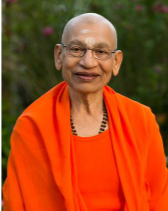
Spirituality: The Vision of Oneness

By Swami Viditatmananda Saraswati*
The vision of oneness, presented by Lord Krishna in the Bhagavad Gītā, is both the goal of life and the means for attaining that goal. The significance of this vision of oneness is understood only when we understand the conflicts and stresses that accompany a belief in the reality of duality.
Duality
We see duality or differences everywhere in creation. We do not see equality of any two things in this world. In fact, we find variety in terms of looks, nature, strength, function and other special features amongst all – sentient and insentient.
The variety in the nature of all beings, sentient and insentient, is sought to be explained by the different proportion of gunas of sattva, rajas and tamas, which are the qualities of prkriti, or primordial nature, of which they are made up. Consequently, there is variety in the karma (actions) of all beings, and as a result, we perceive differences everywhere.
Duality is thus experienced by us as the duality between the individual and the universe, between one individual and another, as well as between the individual and the Lord. The perceived diversity that is at the level of upādhi, or name and form, is taken to be real. The sense of duality that arises from the perception of differences is also taken to be legitimate.
The psychology of taking duality to be real is the psychology of likes and dislikes, which arises from taking oneself to be the body alone, which in turn results in a basic sense of inadequacy, isolation and helplessness. Once I have this basic sense of inadequacy and insecurity, every experience is going to be interpreted in terms of being helpful, harmful or neutral.
The Psychology of Likes and Dislikes
We experience happiness and feel a sense of comfort whenever we find a person or situation favourable to us. Loving to repeat the same experience of happiness, we constantly manoeuvre to recreate the favourable situation. And whenever we face an unfavourable situation, we feel discomfort and stress. Then there is a constant attempt to avoid or get rid of the situation. In this way, rāga and dvesa, likes and dislikes, are formed. When one’s activities are prompted by likes and dislikes, one’s actions are often impulsive and this leads to conflict both within and without. Anxiety and grief follow in the wake of conflict. In this way, a life based on giving reality to the sense of duality perpetuates samsāra, which is nothing but a chain of disquiet and unhappiness.
Samatā – Sameness
Is this sense of duality, born of the perceived differences, the truth or reality about life? No. The truth is that there is unity in diversity. Then why is it that we do not see unity?
The unity is not seen only because we have taken perceived differences to be very real. When we inquire, we find that there is no rule that what is perceived is necessarily real. Look at the assortment of pots, saucers, and jars made of clay. At first glance, each appears to be different from the others. But are they really different? No. One clay alone manifests as an assortment of pots, saucers and jars. When we fail to recognize this fact we are deluded and confused into thinking there are many objects when actually there is only one clay.
Although we pick out differences with our sense organs, duality or differentiation is not real. And it is important to have a vision of oneness because that is the truth. The Lord in the Bhagavad Gītā says:
Samam sarvesu bhūtesu tisthantam parameśvaram vinaśyatsu avinaśyantam yah paśyati sa paśyati
The one who sees the Lord as existing equally in all beings, and as the one who is imperishable among the perishable, he sees.(B.G 13.27).
This verse points out that the indestructible, timeless Lord exists equally in the entire universe, in all different objects. Every object in the universe is constantly changing, and subject to time. Yet the Lord exists in all objects as the one who is Imperishable, Changeless. The Changeless, Imperishable Lord is the connecting link who lends harmony and order to the whole universe, just as the thread that connects the different flowers in a garland is the support of all the flowers in the garland, because of which the flowers enjoy an order and a harmony.
What looks different externally, at the level of name and form, has its basis in unity alone and that alone is the truth.
Look at our body, which is made of many parts, each different from the other. Each limb has a different name, place and function. There is no competition among them. Moreover, there is cooperation among all of them, so that they all work together in unison. Every part, every cell, functions for the benefit of the whole body. Whenever there is a need for help in any one part, the whole unit responds to assist it. Why? Because one conscious self (ātmā) is the support of all of them, without whom they could neither exist nor enjoy sentiency.
Similarly, the Lord, who is non-dual, and whole, exists as the self of all, pervading all, lending existence and vitality to all. The Lord is the same in all the different parts that make up this universe. The person who sees the Lord as equally present in all is the one who really sees.
What is the meaning of ‘even though seeing, they do not see’? It means that although the person sees the object, he or she does not see it as it is. For example, because of dim light, a person sees a snake where in fact there is only a rope. Certainly, something was perceived, but it was an incorrect perception. All kinds of problems arise because of this erroneous notion. The harmless rope becomes the cause of the fear born of seeing a snake! Once there is fear, the poor rope is forsaken and not accepted.
Just as because of the notion of the rope, the snake is not seen, so too, because of the notion that the differences and variety in external objects are real, the Lord who is one and equal in all, is never perceived. Taking the snake to be real, fear arises. In the same way, taking the world to be real, there is fear.
Oneness
The Lord – who is non-dual, undivided – is real, and the world, which appears dual, is not. It is the rope alone that appears as a snake. So also, the Lord alone shines in the form of the whole universe.
However, owing to ignorance, there is no awareness of the reality of oneness. Then taking duality to be real, there is fear and grief in life. All our sorrow, grief, likes and dislikes are born of ignorance alone. That is why the Lord says that the ignorant person, even though seeing, does not see. Only the wise person really sees.
Lord Krishna points out the benefit of seeing the Lord, who is the one in the many, equal amongst all differences and permanent in the impermanent.
Samam paśyan hi sarvatra samavasthitam īśvaram na hinasty ātmanātmānam tatao yāti parām gatim
Because of seeing the Lord as the one who is present alike everywhere, he does not destroy himself by himself. Therefore, he attains the ultimate goal (B.G. 13.28).
Here the Lord says that the wise person who perceives the Lord as the very essence of oneness everywhere does not destroy himself by himself. In effect, this means that the one who is ignorant of this truth, who has no discrimination, destroys the self by the self.
To be continued…
*Swami Viditatmananda Saraswati has been teaching Vedānta Prasthānatrayī and Prakaraṇagranthas for the last 40 years in Ahmedabad, Gujarat. Throughout the year, he conducts daily Vedānta discourses, accompanied by retreats, and Jñāna Yajñas on Vedānta in different cities in India and in foreign countries.





